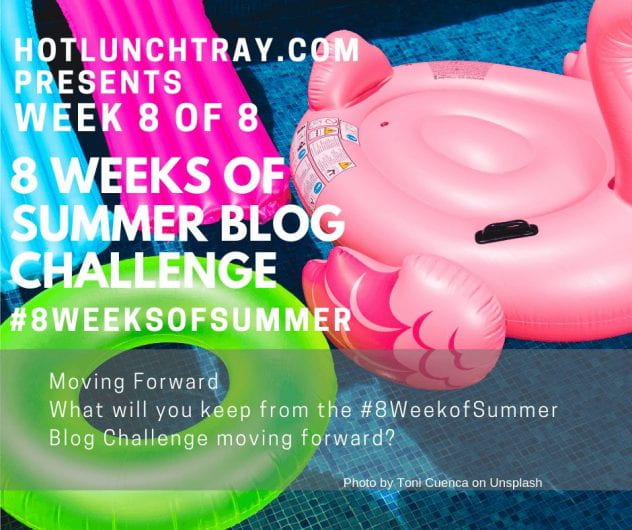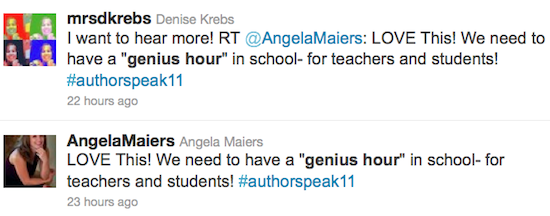- You can play Kahoot! virtually without all the students being in the same place.
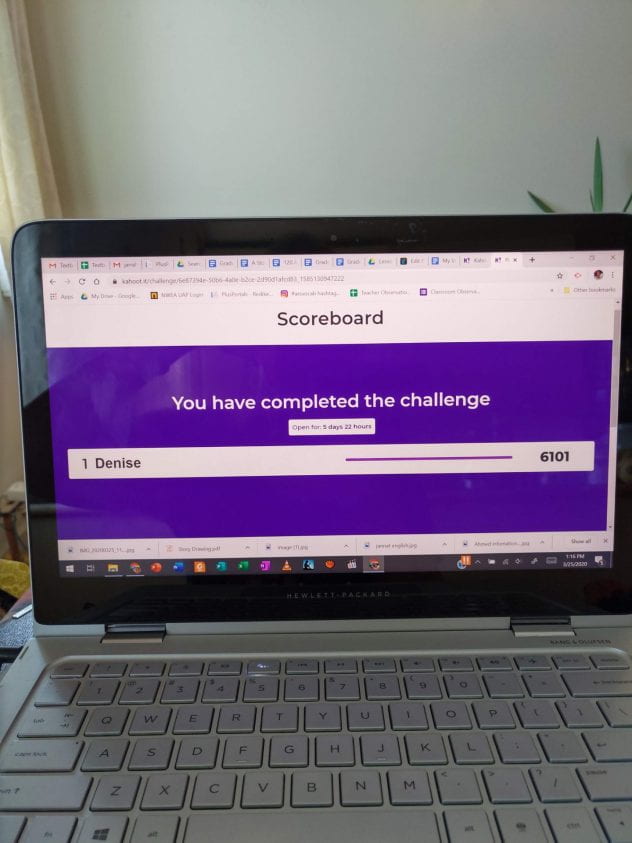
We are now in a five-day long game! This week I wanted my students to play a Kahoot game where they would guess some facts about me. I’m not that experienced with Kahoot, but I thought they would need to see my screen. Yesterday I hosted a Zoom meeting and about 14 people were able to come. Today I learned I can play asynchronously, so I set up another game for those who weren’t able to play the first time.
- I love to play games and my husband does not. Today I ventured out to the grocery store because there will be a two-week shut-down of all the shops except for groceries and pharmacies. I’m planning to stay in during that two-week period, so I went out to get a few fresh fruits and vegetables, along with some canned and frozen veggies. (We eat a lot of vegetables.) I also picked up a game. It is called Digital Game, but it’s not a digital game at all. It is actually a Rummikub knockoff. I may have to play alone though because my game-playing friends and I are socially distancing, of course. So, will Digital Game “bring people together” as the package says? We’re going to have to wait and see.
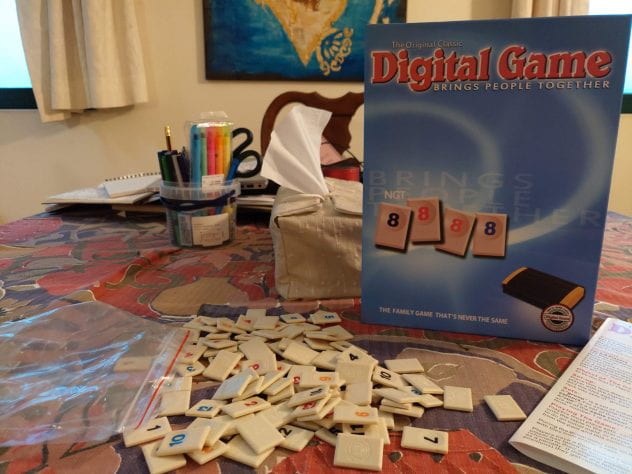
- I have herbs and spices and I’m not afraid to use them. Today I made a frittata without a recipe, just diced up some celery, fresh dill, and capsicum. Then I sprinkled in turmeric and zaatar. It was delicious. That was something new for me. I’ve never been a risky cook in any sense of the word, but this at-home stuff is making me learn.
- I must have had a really good immune system. I have been washing my hands and using hand-sanitizer, not nearly as often as they tell us we should, but more than before. Back in the day (by back in the day, I mean my whole life except for the past Coronamonth), I have not washed my hands all that much, or used hand sanitizer ever. I guess my immune system has been good because I haven’t been sick in three years. (Knock on wood)
- Virtual assignments are best when students have to respond personally. I have some teacher friends who have seen copy-paste of assignments turned in, some students copying wrong answers with the exact same misspelled words. I am happy to say, though, that the vast majority of my lessons have needed sweet answers from the students. They wrote pen pal letters to a class in Arizona, which is also doing virtual learning now. They asked and answered “getting to know you” (or remember you) questions about me and themselves. We’ve had fun with that this week.
- Communication is the reason for language. This one goes with the one above. How much reading and writing we are doing this month! Handling this kind of learning is a real-life lesson for my language learners and their parents, who are all building their skills in English.
- I learned how to add an end page to a YouTube video. We are trying to figure out the best and safest way to upload videos. Some of our teachers are afraid of YouTube, afraid of the videos that will come up after their students finish watching their video, and afraid of the ads they will see. I had never thought of that, to be honest, but a colleague and I were put on a mission to find the best and safest way to upload videos.
- My husband is getting slap happy. Today he called and told me to check the smoking toilet. I went in to find this…

- Zoom is a pretty good program. I’ve been in or watched my husband in three Zoom meetings today. I need to keep learning because I’ve made lots of little mistakes with it. It’s embarrassing when you are just learning but there is video and audio evidence of all your foibles.
- I miss my students more today than yesterday. I learn this anew every day.
Tag: lifelong learning
What Will I Keep?
This post is week 8 of 8 in the 8 Weeks of Summer Blog Challenge for educators.
The #8WeeksofSummer blogging challenge will stay with me. One takeaway is that I do better at blogging with a challenge. I’ve been blogging for close to ten years now, sometimes more regularly than others.
Here is a little history of my recent blogging:
In 2019, I made 16 posts. I began the year blogging, thanks to the #Blogging28 challenge last January through Edublogs, posting 5 times in January. In February through May, I made 3 more posts–no challenges. Then starting in June through today, I’ve made 8 posts in the #8WeeksofSummer challenge.
In 2018, I made 3 posts.
In 2017, I made 57 posts.
What was the difference between 2017 and 2018? Blogging challenges.
In 2017, I took two challenges, the #edublogsclub and #SliceofLife2017, which was each day in March and some Tuesdays after. In 2018, I took no challenges.
Writing heals and keeps me sane, so I need to take time to write. If blogging challenges are a way to encourage me to do that, I will take them.
Thank you so much to Penny Christensen for running this professional reflection challenge for this summer. Thanks also to Penny and other friends who came and commented on my blog–Sheri, Joy, and Scott.
Now. what will my next challenge be?
A Year of Genius Hour – What Have I Learned?
The learners in my class of 2017 are geniuses. For over a year now, these students have had a chance to shape the agenda of their learning, at least part of the time. Because of genius hour, my students are learning to care again about learning. They choose what they will learn based on what they wonder about, what they are good at, and what they are passionate about.
It was a little over a year ago when I read a tweet by Angela Maiers about Daniel Pink‘s keynote address about motivation. I had seen the video “The Puzzle of Motivation“, and I had read his books A Whole New Mind and Drive. I had yet to fully translate the work to my students.
I had an epiphany after I read Angela’s tweet and later this blog post by Daniel Pink, “Genius Hour: How 60 minutes a week can electrify your job.” I knew that according to Pink, we are motivated with autonomy,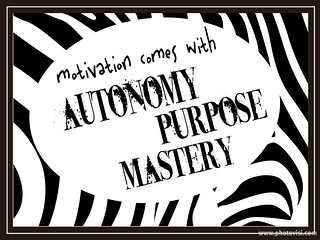 purpose, and mastery. If we want motivated students, why not let students become motivated by giving them autonomy to master what they wish for their purpose? It makes sense! Why NOT, indeed?
purpose, and mastery. If we want motivated students, why not let students become motivated by giving them autonomy to master what they wish for their purpose? It makes sense! Why NOT, indeed?
So, our first genius “hour” was a three-hour block of time on the Wednesday morning before (American) Thanksgiving in 2011. It was such a thrill to watch the students fully engaged in purposeful learning, creating, producing, and mastering. They chose what they wanted to work on.
We have continued to find our way through genius hour learning over the past 15 months. People often ask me if the students have trouble staying on task. To those people I say a resounding, “No, they do not have trouble staying on task.” (However, as most teachers can attest, they sometimes do when we aren’t in genius hour, when I am dictating the agenda.)
Skeptics and future genius hour teachers alike also ask, “Do students take advantage of the freedom?” “Yes, fully!” I say with enthusiasm. They love the learning environment during genius hour. They use every moment wisely. In fact, one of my favorite things during our first genius hour morning was when the bell rang after the first period. (The bells continued to ring because our high school students were in regular classes that morning.) Initially when we heard the bell, I saw the look of disappointment on their faces. Then a look of sunshine and delighted cries of “Ooh, we don’t have to leave!” (Chances are good that most of us don’t normally hear that kind of reaction at the end of a first period class.) All morning students continued to learn, ignoring bells, only taking an occasional bathroom break.
Now, to be sure, I know what people REALLY mean when they ask, “Do they take ‘advantage’ of the freedom?” They mean, “Do students screw around, instead of learning on their own?” To that I answer absolutely NOT. They have purpose. They have chosen what they want to learn; no one dictated it. They are given freedom to take as long as is needed to be satisfied with their learning.
Now that we have genius hour each week for two periods (20% of our time together), I have students for whom that is not enough. They work on their genius hour projects during study halls, before school, at home, and during recesses. They are passionate because they have chosen purposeful learning.
However, there is one negative that has cropped up over this past year, which I am just starting to figure out. In about 10-20% of students, their actions seem to say, “Too much freedom; just tell me what to do.” They don’t screw around really, but they don’t seem able to take hold of the learning for themselves. Typically I see these few trying to partner up with other students who have an idea. Then the more reluctant one acts as a helper of sorts for the other student’s learning. They sometimes want to switch alliances as they lose interest in their first partner or group. They are not fully engaged. (As opposed to what also happens — two or three students with the same passion join forces for a group project.)
In an attempt to alleviate the problem of the 2 or 3 students in a class who struggle finding their genius, I’ve been asking them to reflect upon these three prompts.

I keep working with them until they are willing and able to list their 30 “genius” ideas. (It is especially hard for some of them to admit to ten things they are good at). The lists become great conversation starters about what a learner might do for genius hour.
Sir Ken Robinson explains in The Element that when someone doesn’t know how to read and write, we don’t assume they are incapable of literacy. Instead we know that they haven’t yet learned how to read and write. In a similar manner, he explains, when someone isn’t creative, we should not assume that they are incapable of creativity. We should assume they just need to be taught.
I am trying to teach my students how to be creative.
The next graphic shows the Universal Constructs from the Iowa Core. These building blocks for success in the 21st century align perfectly with genius hour learning. I have had one-on-one conferences with my less creative students, showing them these “building blocks for success” and holding them accountable for the work they do during genius hour. Sometimes it means having a learner write an analysis of why he chose to abandon an idea. Or helping another learner find a way to be flexible and adapt instead of abandoning her idea. I have listened to struggling small groups (limited to 2-3 people per group) as they figure out how to collaborate more effectively.
Next up in my what-I-learned series is to make a video to show genius hour from my students’ perspective. For now, though, I will share a video created by Gallit Zvi, another genius hour leader. It shows great work by her geniuses. I used it to introduce genius hour to my new class this year.
More Resources:
- Genius Hour wiki
- Genius Hour Blog Post Index – A list of posts from my genius hour beginnings and links to other teachers’ work.
- Center for Digital Education’s “Google’s 80/20 Principle Applies to Students“
- Education is My Life – “Designing 20% Time in Education“
- 2/15/13 – I did finish my latest “What is Genius Hour?” video.
- #geniushour Twitter Chat on the first Thursday of the month at 9:00 p.m. EST
- 3/18/13 – A comprehensive Genius Hour Livebinder by Joy Kirr.
All images are shared with a CC Attribution license. You are free to use them, just click on image for more info.
